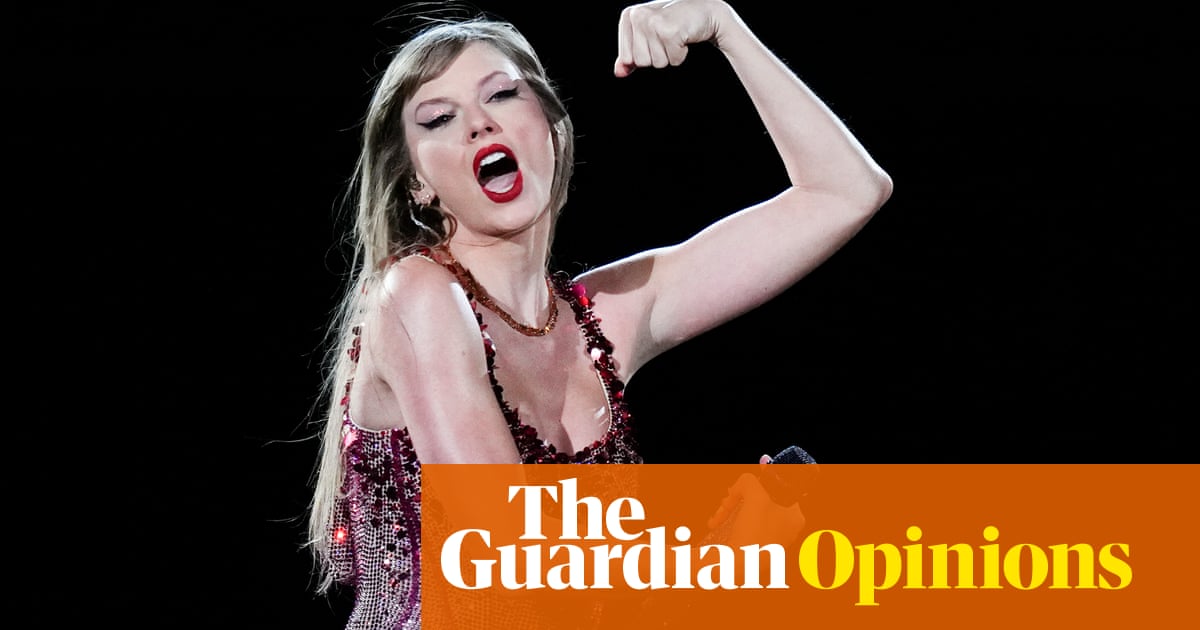
In every sense, Taylor Swift is an outlier. This week her Eras Tour film became the highest-grossing concert film in box office history, taking the record from Michael Jackson’s 2009 movie This Is It. She was the only artist who placed in the chart of the UK’s Top 10 albums of 2023 with a new album rather than an older one (albeit with a re-recording of her 2014 pop breakthrough 1989). Last year she became the first woman to have four albums in the US Top 10 at the same time, she took the record for the most US No 1 albums by a woman from Barbra Streisand, the Eras tour became the first ever to earn more than $1bn, and in October Swift herself was estimated to have become a billionaire. In November, a US publication hired a dedicated Swift reporter – though the joke is that everyone in entertainment media pretty much does the same job, given the wild scale of her success.
But beyond commerce, Swift, 34, is also an outlier in terms of how she conducts her relationships with her fans and the public. She maintains an unusual level of control in a period when other pop superstars allow themselves to be the subjects of untrammelled interpretation and speculation – Harry Styles thrives on mystery; Beyoncé’s PR strategy appears to be never apologise, never explain – and understand how doing so might satisfy unexpected elements of one’s fanbase, or suggest surprisingly viable commercial paths. Swift rarely gives interviews – though more on that later – and her primary public relations strategy involves seeding fairly obvious clues for her fans to work out her next move, allowing them to feel like active participants in her work while almost always leading them to her desired conclusion. Puppet-mastery is a smart approach, especially for a star who tests the limits of overexposure – allowing her to remain plausibly out of the picture while perpetually in the spotlight and still on her terms.
Occasionally, though, the velvet glove comes off and the tightness of the star’s grip on her narrative becomes felt when people draw the “wrong” conclusions. Last week, the New York Times published a 5,000-word comment piece speculating that Swift is secretly gay – as deduced from various lyrics and costuming choices – and suggesting that she owes it to queer fans and less privileged musicians to come out. These notions are not news to the Swift hardcore, a significant number of whom identify as “Gaylor” conspiracists, certain that she has dated women throughout her life. But fans gleefully cross-referencing lyrics and dates online – often seeking an affirmative reflection of their own desires – is one thing. A major global publication writing a prescriptive, even chastising, article seems both trivial and sinister – a good old-fashioned celebrity outing under the guise of social conscience, and one that unhelpfully essentialises sexuality to a behavioural code. And as a much better NYT comment piece on queerbaiting put it last year: “As self-serving as some celebrity caginess can be, you can’t build a world in which everyone feels free to self-identify by ordering everyone to self-identify.”
Surprisingly, Swift’s usually invisible team – or “a person close to the situation”, as CNN reported – hit back. “Because of her massive success, in this moment there is a Taylor-shaped hole in people’s ethics,” they told CNN. “This article wouldn’t have been allowed to be written about Shawn Mendes or any male artist whose sexuality has been questioned by fans. There seems to be no boundary some journalists won’t cross when writing about Taylor, regardless of how invasive, untrue and inappropriate it is – all under the protective veil of an ‘opinion piece’.”
The response felt almost as heavy-handed and misguided as the original piece. Male artists including Shawn Mendes and Harry Styles have in fact been the subjects of massive speculation about their sexualities: the NYT writer previously published a similar piece about Styles, while Mendes has spoken of the pressure of the constant discourse about his identity. (“I thought, ‘You fucking guys are so lucky I’m not actually gay and terrified of coming out,’ ” he told Rolling Stone. “That’s something that kills people.”) And there is no way that gimlet-eyed Swift has made the many references listed by accident: if you lead a horse to water, don’t be surprised when it drinks. Dignifying an overblown essay with such a severe response may in turn act as a rebuke to fans who have found identification and solace – or even just benign entertainment – in imagining, say, that Swift’s gaspingly sexy Reputation song Dress may be about her once-prominent friend, the model Karlie Kloss (“I don’t want you like a best friend”!), rather than its more likely subject, her then-boyfriend Joe Alwyn.
More than ever, pop stardom is an act of collective imagination. Swift may be one of the last monocultural stars – meaning your grandparents may have a passing awareness of who she is; her moves make tabloid headlines, not just niche gossip items, and prompt bland (but hardly offensive) jokes at awards ceremonies – but that monoculture is still a federation of distinct fanbases, each with their own interpretation of her. Thanks to social media, members of each of these Swiftian sub-tribes can find each other and imagine and inhabit their own version of her reality, forming community (if sometimes descending into entitlement). The Swift I enjoy is a little vindictive and surprisingly self-lacerating; others may value her loyalty to her friends, her honesty about her experiences with disordered eating, her goofiness, her assiduous capitalist instincts, or may have found in her some other prism through which to understand and appreciate some aspect of their identity – all of them valid parasocial relationships. Arguably, what Swift serves up is a constructed fiction with herself as the central character: why shouldn’t it compete with others?
It’s these playful and personal mutations that keep a star like Swift interesting at a time when her carefully managed media omnipresence and tightly plotted breadcrumb trails have started to feel a little tedious, laden with thudding predictability. (Does the snake-green dress she wore to the Golden Globes at the weekend mean that the serpent-referencing Reputation (Taylor’s Version) is coming? Is the pope Catholic?) For many onlookers, that wearying feeling struck again when reading her lone recent interview, for Time’s person of the year cover, which seemed disappointingly uninquiring and intent on validating her version of events – namely that she was “cancelled” in the wake of her feud with Kim Kardashian and Kanye West, when in fact it resulted in one of the most successful albums of her career – rather than pushing deeper into the fertile ground where her self-conception rubs up against public interpretation. The most abiding images of Swift this past year show pop’s biggest outlier standing alone on stage at the Eras tour, bedazzled with sequins. She cuts a formidable figure in her class of one – but it’s in the unruly exquisite corpse of pop fandom and stardom that the most meaningful rewards are found.












